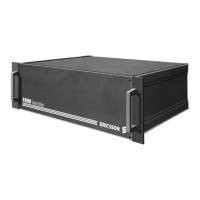F800 CIRCUIT DESCRIPTION
4 (25)
Uppgjord (även faktaansvarig om annan) -
Prepared (also subject responsible if other)
Nr -
No.
KL/ECS/S/LT Magnus Lindahl ECS/S/LT-96:5044
Dokansv/Godk -
Doc respons/Approved
Kontr -
Checked
Datum -
Date
Rev File
KI/ECS/S/LTC 1996-06-06 A
965044.DOC
RADIO BOARD
There are a number of different radio boards for F800, both for simplex operation as
well as duplex operation. Common for all versions of the radio board is that they are
divided into a number of function blocks. Each block has a specific function. The
number of function blocks depending on the operation mode and frequency band. The
radio board is controlled by the CPU- board by a number of different signals. The
following blocks and signals are found on the radio board:
!"
Frequency generator.
In simplex versions one frequency generator is used and in
duplex versions there are two frequency generators used. The frequency generator is
controlled by the CPU- board with
channel information
and
latch
signals. From the
frequency generator a
locking
signal is send to the CPU- board. To achieve a faster
locking of the frequency generator the frequency band is divided into four bands. The
band selection is done from the CPU- board by the
band selection
signal. In simplex
mode the same frequency generator generates both
1st local oscillator
signal and
transmitter carrier
. Duplex one frequency generator is used to generate local oscillator
and a second generator is used for generation of transmitter carrier. All modulation is
done in the frequency generator. There are two modulation signals used,
mod FM
and
mod PM
.
!"
Receiver.
Converts RF signals to AF signals. The receiver is a double super het-
erodyne type. The receiver
DATA
and
SPEECH
signals are connected to the CPU-
board. A
SQUELCH
signal as well as a
RSSI
signal is obtained from the 2nd IF in the
receiver. These two signals are used by the CPU- board. To optimise the function of
the receiver, the front end is electrically tuned from the CPU- board by the
RF- tuning
signal.
!"
Transmitter.
The transmitter amplifies the modulated signal from the frequency
generator. The transmitter output is controlled by the
transmitter control
block on the
radio board and by the CPU- board. The output power can be set in two different lev-
els, the CPU- board selects high or low output with the
power red
signal. The
transmitter is monitored by the control block and as long as the transmitter delivers
output power the
power ind.
signal is active.
!"
Antenna switch.
Simplex only. The antenna switch controls the RF signal path and
switches the antenna to either the receiver or the transmitter. The antenna switch is
controlled by the DC power supply on the radio board. In duplex mode an external
duplex filter must be used.
!"
Power supply.
DC power supply, 5 V, 10 V and 12 V, for the different function
blocks on the radio board. The power supply also contains fuses and DC filters. The
power supply also controls the transmitter on/off and the antenna switch, this is
indirectly done by the CPU- board with the
TX on
signal. The DC power supply is
controlled by the CPU- board with the
On/Off
signal.

